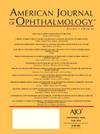Incidence of Giant Cell Arteritis Following Herpes Zoster Ophthalmicus: A Multicenter Retrospective Cohort Study
IF 4.1
1区 医学
Q1 OPHTHALMOLOGY
引用次数: 0
Abstract
Objective
To evaluate the long-term risk of incident giant cell arteritis (GCA) following herpes zoster ophthalmicus (HZO).
Design
Retrospective cohort study.
Participants and Controls
Adults aged ≥50 years with a diagnosis of HZO (ICD-10 B02.3) between May 2005 and April 2024 were identified from the TriNetX Global Collaborative Network and compared to controls without any history of zoster. All patients had ≥6 months of data before and after the index date. Individuals with prior diagnoses of GCA, polymyalgia rheumatica, HIV, or transplant status were excluded.
Methods
Propensity score matching (PSM) was applied in a 1:1 ratio to balance baseline characteristics. Time-to-event analysis was performed using a Cox proportional hazards model and a log-rank test, with cumulative incidence illustrated by a Kaplan–Meier curve. Sensitivity analyses evaluated the impact of antiviral therapy and prior zoster vaccination.
Main Outcome Measures
Incident GCA (ICD-10 M31.5 or M31.6), assessed beginning 30 days after index diagnosis. The E-value was calculated to assess robustness against unmeasured confounding.
Results
After matching, 18 154 patients were included in each cohort (mean age, 66.6 years; 57.5% female). During 10 years of follow-up, GCA occurred in 42 HZO patients and 14 controls, corresponding to incidence rates of 49.9 vs 16.2 per 100 000 person-years (log-rank P < .001). HZO was associated with a more than threefold increased risk of GCA (HR, 3.09; 95% CI, 1.69–5.65). The E-value was 5.63 for the HR and 2.77 for the lower confidence limit. In sensitivity analyses, antiviral therapy initiated within 7 days of HZO diagnosis was not associated with a reduced risk of GCA (HR, 0.86; 95% CI, 0.43–1.68), and herpes zoster vaccination administered ≥1 month before HZO diagnosis showed no protective association (HR, 1.60; 95% CI, 0.55–4.66).
Conclusions
In this large real-world cohort, HZO was associated with an increased risk of incident GCA, although the absolute risk remained low. Further research is needed to clarify pathophysiologic mechanisms and the potential impact of antiviral or vaccine-based interventions.
眼带状疱疹后巨细胞动脉炎的发生率:一项多中心回顾性队列研究
目的评价眼带状疱疹(HZO)术后发生巨细胞动脉炎(GCA)的长期风险。设计回顾性队列研究。参与者和对照组从TriNetX全球协作网络中确定2005年5月至2024年4月期间诊断为HZO (ICD-10 B02.3)的年龄≥50岁的成年人,并与无带状疱疹病史的对照组进行比较。所有患者在索引日期前后均有≥6个月的数据。既往诊断为GCA、风湿性多肌痛、HIV或移植状态的个体被排除在外。方法采用倾向评分匹配(PSM),以1:1的比例平衡基线特征。采用Cox比例风险模型和log-rank检验进行时间-事件分析,累积发生率用Kaplan-Meier曲线表示。敏感性分析评估了抗病毒治疗和既往带状疱疹疫苗接种的影响。主要结局指标事件GCA (ICD-10 M31.5或M31.6),在指标诊断后30天开始评估。计算e值以评估对未测量混杂的稳健性。结果匹配后,每个队列共纳入18154例患者(平均年龄66.6岁;57.5%的女性)。在10年的随访中,42名HZO患者和14名对照组发生了GCA,对应的发病率为49.9 vs 16.2 / 100,000人年(log-rank p < 0.001)。HZO与GCA风险增加3倍以上相关(HR, 3.09;95% ci, 1.69-5.65)。HR的e值为5.63,下限为2.77。在敏感性分析中,HZO诊断后7天内开始抗病毒治疗与GCA风险降低无关(HR, 0.86;95% CI, 0.43-1.68),在HZO诊断前≥1个月接种带状疱疹疫苗没有保护性关联(HR, 1.60;95% ci, 0.55-4.66)。结论:在这个庞大的现实世界队列中,HZO与GCA发生风险增加相关,尽管绝对风险仍然很低。需要进一步的研究来阐明病理生理机制以及抗病毒或基于疫苗的干预措施的潜在影响。
本文章由计算机程序翻译,如有差异,请以英文原文为准。
求助全文
约1分钟内获得全文
求助全文
来源期刊
CiteScore
9.20
自引率
7.10%
发文量
406
审稿时长
36 days
期刊介绍:
The American Journal of Ophthalmology is a peer-reviewed, scientific publication that welcomes the submission of original, previously unpublished manuscripts directed to ophthalmologists and visual science specialists describing clinical investigations, clinical observations, and clinically relevant laboratory investigations. Published monthly since 1884, the full text of the American Journal of Ophthalmology and supplementary material are also presented online at www.AJO.com and on ScienceDirect.
The American Journal of Ophthalmology publishes Full-Length Articles, Perspectives, Editorials, Correspondences, Books Reports and Announcements. Brief Reports and Case Reports are no longer published. We recommend submitting Brief Reports and Case Reports to our companion publication, the American Journal of Ophthalmology Case Reports.
Manuscripts are accepted with the understanding that they have not been and will not be published elsewhere substantially in any format, and that there are no ethical problems with the content or data collection. Authors may be requested to produce the data upon which the manuscript is based and to answer expeditiously any questions about the manuscript or its authors.

 求助内容:
求助内容: 应助结果提醒方式:
应助结果提醒方式:


